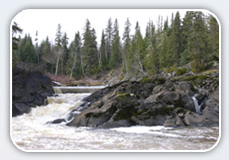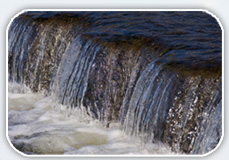History of Waterpower
Beginning well over 2,500 years ago, waterpower has had a very long and important role in human history – a role which continues to evolve today.
The Chinese were probably the first to use a water wheel, harnessing the flow of water to grind grains and irrigate fields. This useful technology turned up in Persia, and, when the Greeks conquered the Persians around 400 BC, the first recorded use of the water wheel appears. The Greeks began the process of using power and energy from water in order to grind wheat into flour and saw stone and timber.
This knowledge was passed on to the Romans who further developed waterpowered technology. The Romans built aqueducts to channel mountain streams into towns and cities to provide clean water for bathing, drinking and field irrigation. Some of these aqueducts still stand today.
Increasingly, water wheels became more common and were soon found on nearly every river in the European continent. The Doomsday Survey of 1086 records 5624 water wheels in England alone. In 1581, a water wheel was installed under the old London Bridge as it was discovered that water ran faster through an arch. This device became the early blueprint for water powered textile-making machinery developed during the Industrial revolution.
Water turbine advances developed throughout the 18th and 19th centuries and were soon brought to North America. By 1880, theatre and storefront lighting was powered by a nearby water turbine in Grand Rapids, Michigan, but the true turning point came two years later at the 1882 World Expo in Munich, Germany when transmission of waterpower electric power was first demonstrated. With a direct current of 2,400 volts, power was transmitted almost 60 km away. This same year saw the world's first water powered electricity generating plant begin operation on a river in Wisconsin. By 1886 there were close to 50 waterpowered electric plants in the U.S. and Canada.
The first known effort to harness the waters of Niagara Falls was in 1759, when a small canal was built in order to power a sawmill. In 1906, the province of Ontario initiated power transmission operations under a publicly owned utility, while private enterprises on both the Canadian and American sides of the border were responsible for generation.
Ontario’s present day electrical system began when Sir Adam Beck began building a publicly owned waterpower-electric generating plant to maximize the power of the Niagara River.
Between Lake Erie and Lake Ontario, the Niagara River drops a dizzying 326 feet (99m) (about twice the height of the Falls). Bringing water from the upper Niagara River at Chippawa and around the Falls along the top of the gorge, Beck created his own Niagara Falls with a drop of 320 feet (97m). With this drop, every cubic foot of water equates to approximately 29.6 horsepower of energy per second.
In 1917, Ontario Waterpower Power Commission, headed by Sir Adam Beck, purchased the Ontario Power Company and its Waterpower-electric generating plant ,located below the Horseshoe Falls. So began what was to become the largest publicly owned utility in the world.
Throughout the 20th century rivers and streams in Ontario and Canada were harnessed to feed the development of industry, towns and cities. The prosperity of the province is owed in a large part to the waterwheel and the rivers that powered them.











